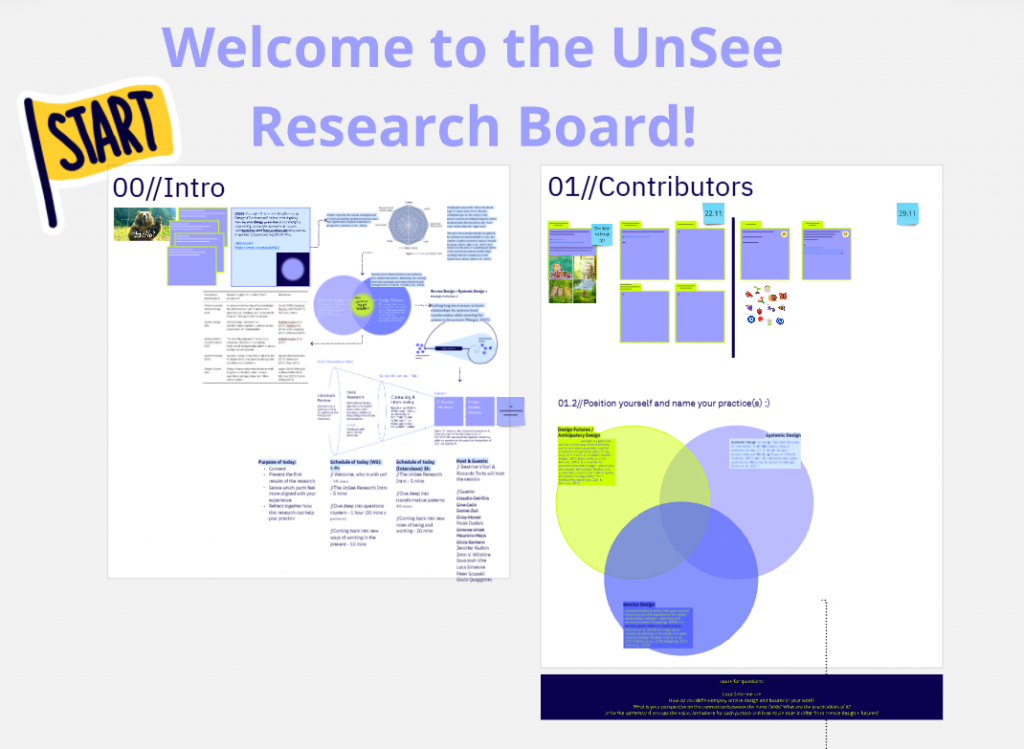UnSee Update #6 // November 2024
Words by: Riccardo Torta
This month has been a whirlwind of many different activities happening for the UnSee team and research, just as the crisp winter air of November starts to invade Milan, we felt like those leaves outside our office flying around the campus and exploring familiar spaces in service design from a new perspective. Among the activities of this month, we had both moments to reflect together within our team but also moments in which we disseminated our work through lectures to students and conversations with external experts. This first part of our monthly update will be focussing on such conversations with experts, as we want to present the process and directly thank those who participated (or have not yet) in conversations about the first results of this research.
During the past few weeks, we have been in contact with different academics and expert practitioners, connecting the three perspectives that characterize UnSee (SD, SYD, DF). We labelled this process “validation” but, with a retrospective eye, I think it brought far more than validity to our early results. This process was structured following two types of sessions according to the expertise of those we engaged.

We engaged academic experts in a one-to-one interview format, presenting our results and using the three transformative patterns we introduced at the RSD13 Conference as starting points (see previous post for more information). The aim of these sessions was to take a zoom-out perspective towards the disciplinary boundaries that our research is touching, raising questions connected to what new type of service design are we talking about. In particular, we tried to understand what maintains the unicity of the three perspectives, where service design, systemic design and design futures essentially differ in terms of thinking processes and frameworks.
With expert practitioners instead, we tried out a different approach aimed at fostering meaningful connections between their different ways of designing driven by, most of the time, very similar intents. Therefore, we organized sets of different collective discussions taking a zoom-in perspective into the implications of our results for their design practice. Together we questioned the reliability of the results and how much the practitioners were able to recognize themselves within the transformations we outlined. Such discussions emerged critical aspects that we did not consider before but also showed the many challenges and co-existence that practitioners have to sustain in their work.


The analysis of this process is still ongoing, with more conversations planned at the beginning of December, but I feel it is worth sharing some of the learning points so far:
Never-ending transformations; as we find ourselves dealing with greater unknowns, the process of transitioning away from unsustainable and oppressive systems and futures becomes a long-term project in itself. Away from solutionism and presumptions of finding the right answer, transformation processes acquire an indefinite temporality driven by a constant willingness to do things differently from the business as usual in a regenerative perspective.
Momentum and time; systems embed time within them through “maintenance loops”: time cycles that strive to keep the relationships between actors, resources and products in place over time. But sometimes these maintenance loops suffer a crisis that requires them to respond in a new way, and that’s when the momentum gained by such responses can be used for transformative actions, favouring the emergence of new radical paradigms.
Ontological unknowns; are we daring a little too much when we talk about understanding and mapping systems or crafting desirable futures? That is a question that is slowly emerging for us, as we come to understand better the inherent uncertainty of both systems and futures. To this end, we are seeing the emergence of approaches that add a new layer of interpretation beyond the aim to map and govern such materials of design. Practices that try to look inwards within each actor and foster a more personal understanding of how the actors relate to systems and futures that cannot be fully grasped.
These are just seeds for further reflections, nevertheless, it might be important to share them and see in the field of design practitioners, if someone relates or not. Anything that can spark further discussion is a win for us. I wanted to conclude by thanking from the bottom of our hearts those who participated in our sessions. Their contribution was invaluable and cannot be fully packaged in this post, so thanks a lot.
